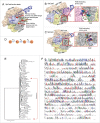Optimization of genome editing through CRISPR-Cas9 engineering
- PMID: 27340770
- PMCID: PMC4927198
- DOI: 10.1080/21655979.2016.1189039
Optimization of genome editing through CRISPR-Cas9 engineering
Abstract
CRISPR (Clustered Regularly-Interspaced Short Palindromic Repeats)-Cas9 (CRISPR associated protein 9) has rapidly become the most promising genome editing tool with great potential to revolutionize medicine. Through guidance of a 20 nucleotide RNA (gRNA), CRISPR-Cas9 finds and cuts target protospacer DNA precisely 3 base pairs upstream of a PAM (Protospacer Adjacent Motif). The broken DNA ends are repaired by either NHEJ (Non-Homologous End Joining) resulting in small indels, or by HDR (Homology Directed Repair) for precise gene or nucleotide replacement. Theoretically, CRISPR-Cas9 could be used to modify any genomic sequences, thereby providing a simple, easy, and cost effective means of genome wide gene editing. However, the off-target activity of CRISPR-Cas9 that cuts DNA sites with imperfect matches with gRNA have been of significant concern because clinical applications require 100% accuracy. Additionally, CRISPR-Cas9 has unpredictable efficiency among different DNA target sites and the PAM requirements greatly restrict its genome editing frequency. A large number of efforts have been made to address these impeding issues, but much more is needed to fully realize the medical potential of CRISPR-Cas9. In this article, we summarize the existing problems and current advances of the CRISPR-Cas9 technology and provide perspectives for the ultimate perfection of Cas9-mediated genome editing.
Keywords: CRISPR-Cas9; efficiency; genome editing; specificity.
Figures

Similar articles
-
[CRISPR/CAS9, the King of Genome Editing Tools].Mol Biol (Mosk). 2017 Jul-Aug;51(4):582-594. doi: 10.7868/S0026898417040036. Mol Biol (Mosk). 2017. PMID: 28900076 Review. Russian.
-
Precision genome editing in the CRISPR era.Biochem Cell Biol. 2017 Apr;95(2):187-201. doi: 10.1139/bcb-2016-0137. Epub 2016 Sep 29. Biochem Cell Biol. 2017. PMID: 28177771 Review.
-
Genome editing using CRISPR/Cas9-based knock-in approaches in zebrafish.Methods. 2017 May 15;121-122:77-85. doi: 10.1016/j.ymeth.2017.03.005. Epub 2017 Mar 12. Methods. 2017. PMID: 28300641 Review.
-
Versatile and precise gene-targeting strategies for functional studies in mammalian cell lines.Methods. 2017 May 15;121-122:45-54. doi: 10.1016/j.ymeth.2017.05.003. Epub 2017 May 10. Methods. 2017. PMID: 28499832 Review.
-
CRISPR Mediated Genome Engineering and its Application in Industry.Curr Issues Mol Biol. 2018;26:81-92. doi: 10.21775/cimb.026.081. Epub 2017 Sep 7. Curr Issues Mol Biol. 2018. PMID: 28879858 Review.
Cited by
-
CRISPR/Cas9 mutagenesis reveals a role for ABCB1 in gut immune responses to Vibrio diazotrophicus in sea urchin larvae.J Exp Biol. 2021 Apr 1;224(7):jeb232272. doi: 10.1242/jeb.232272. Epub 2021 Apr 15. J Exp Biol. 2021. PMID: 33653719 Free PMC article.
-
CRISPR/Cas9-mediated VvPR4b editing decreases downy mildew resistance in grapevine (Vitis vinifera L.).Hortic Res. 2020 Sep 1;7:149. doi: 10.1038/s41438-020-00371-4. eCollection 2020. Hortic Res. 2020. PMID: 32922821 Free PMC article.
-
New Insights into the Therapeutic Applications of CRISPR/Cas9 Genome Editing in Breast Cancer.Genes (Basel). 2021 May 12;12(5):723. doi: 10.3390/genes12050723. Genes (Basel). 2021. PMID: 34066014 Free PMC article. Review.
-
CRISPR-Based Genome Editing for Nutrient Enrichment in Crops: A Promising Approach Toward Global Food Security.Front Genet. 2022 Jul 14;13:932859. doi: 10.3389/fgene.2022.932859. eCollection 2022. Front Genet. 2022. PMID: 35910203 Free PMC article. Review.
-
Harnessing the potential of gene editing technology using CRISPR in inflammatory bowel disease.World J Gastroenterol. 2019 May 14;25(18):2177-2187. doi: 10.3748/wjg.v25.i18.2177. World J Gastroenterol. 2019. PMID: 31143069 Free PMC article. Review.
References
-
- Weninger A, Hatzl AM, Schmid C, Vogl T, Glieder A. Combinatorial optimization of CRISPR/Cas9 expression enables precision genome engineering in the methylotrophic yeast Pichia pastoris. J Biotechnol. 2016 Mar 22. PII: S0168-1656(16)30134-1. http://dx.doi.org/ 10.1016/j.jbiotec.2016.03.027. - DOI - PubMed
-
- Calarco JA, Friedland AE. Creating genome modifications in C. elegans Using the CRISPR/Cas9 System. Methods Mol Biol 2015;1327:59-74; PMID:26423968; http://dx.doi.org/10.1007/978-1-4939-2842-2_6 - DOI - PubMed
-
- Housden BE, Lin S, Perrimon N. Cas9-based genome editing in Drosophila. Methods Enzymol 2014;546:415-39; PMID:25398351; http://dx.doi.org/10.1016/B978-0-12-801185-0.00019-2 - DOI - PubMed
-
- Hu X, Wang C, Fu Y, Liu Q, Jiao X, Wang K. Expanding the range of CRISPR/Cas9 genome editing in rice. Mol Plant 2016. - PubMed
-
- Maresch R, Mueller S, Veltkamp C, Ollinger R, Friedrich M, Heid I, Steiger K, Weber J, Engleitner T, Barenboim M, et al.. Multiplexed pancreatic genome engineering and cancer induction by transfection-based CRISPR/Cas9 delivery in mice. Nat Commun 2016;7:10770; PMID:26916719; http://dx.doi.org/10.1038/ncomms10770 - DOI - PMC - PubMed
Publication types
MeSH terms
Substances
LinkOut - more resources
Full Text Sources
Other Literature Sources
Miscellaneous
